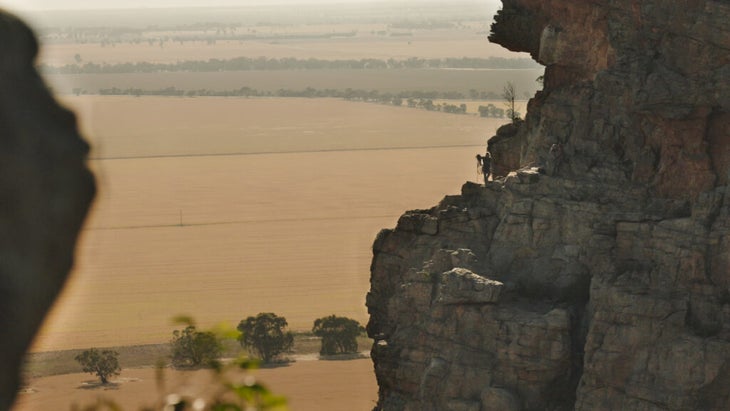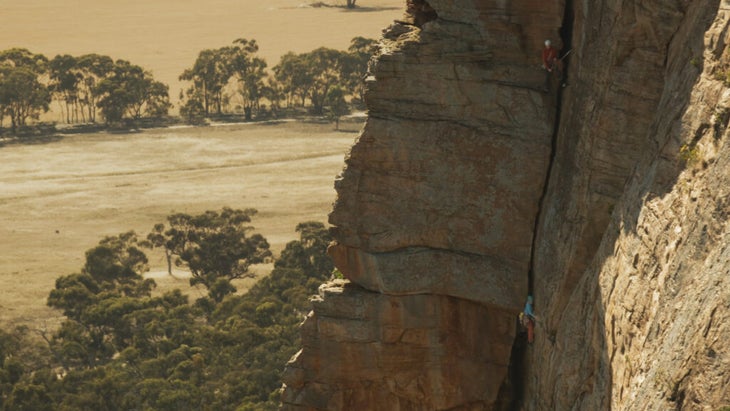Heading out the door? Read this article on the new Outside+ app available now on iOS devices for members! Download the app.
Editor’s Note: This story was updated on January 30 to include additional context about the proposed closures in Australia’s Mt. Arapiles/Dyurrite.
Lucas Corroto has been climbing at Australia’s iconic Mount Arapiles (also known as Dyurrite) since he was 13 years old, when he went on a group trip there led by his woodworking teacher.
“It was my first experience climbing and it is a trip I will never forget,” Corroto remembers.
But soon, he may never be able to climb some of his favorite routes in Arapiles again. Parks Victoria, which manages public lands in the Australian state of Victoria, is threatening to close several climbing areas in the Arapiles, citing cultural preservation and ecological reasons.
The Barengi Gadjin Land Council—which represents the Wotjobaluk, Jaadwa, Jadawadjali, Wergaia and Jupagulk People, who are the Traditional Owners of the Arapiles/Dyurrite area—says that climbers and bolting threatens the rock art and cultural heritage of their land.
Stuart Harradine of the Wotjobaluk Nation says, “Seeing visitors trampling over ceremony sites … or seeing climbing bolts drilled into the bones of our Creation Ancestors or at our rock art sites causes enormous distress to Traditional Owners.” Harradine explains that ultimately, this impacts his people’s health and wellbeing.
Lyn Mace, Deputy Chair of the Barengi Gadjin Land Council, adds that since they’ve called the Arapiles/Dyurrite area home for “tens of thousands of years,” the Traditional Owners of the land “have a legal and cultural obligation to safeguard the irreplaceable cultural heritage of Dyurrite for the Wotjobaluk, Jaadwa, Jadawadjali, Wergaia and Jupagulk Peoples.”
Currently, the Barengi Gadjin Land Council is working closely with Parks Victoria on a new Dyurrite Management Plan, which is open for public comment through February 14. Under this proposed plan, over 1,000 climbing routes may soon become inaccessible, including the world’s first 5.14a: Punks in the Gym. This news comes on the heels of widespread climbing area closures in Grampians National Park, where Arapiles is located, that occurred in 2019.
“They are shutting down the majority of a world-class climbing destination,” Carroto explains, “but they are also shutting down the heart of Australian climbing. Arapiles is to Australia what Yosemite is to the US.”

To advocate against the closure of additional Arapiles climbing areas, Corroto released a short film exploring the heritage of climbing in Arapiles. The film argues that climbers have served as stewards of the land and disputes claims from Parks Victoria and the Barengi Gadjin Land Council about the role of climbers in damaging cultural sites.
Watch the Trailer for Corroto’s Save Arapiles Climbing film here:
We caught up with Corroto to learn more about his new film and how climbers against these climbing closures can support his effort.
Climbing: When did you decide to make this film?
Lucas Corroto: As soon as I heard about the proposed climbing bans in Arapiles, it sparked the idea of shooting a short documentary to cover this complex topic. Two weeks after the announcement, we put all the camera gear in the back of our van and we drove 12 hours to shoot the film.
Climbing: Did you have any supporters in producing this film or was it a passion project?
Corroto: This was a passion project as I didn’t want to compromise on the angle on which I told the story.
Climbing: How long have you been personally climbing at Arapiles? Do you live nearby?
Corroto: I live in the Blue Mountains, 12 hours from Arapiles, and I still drive there multiple times a year. Arapiles is a special place that every climber should experience.
Climbing: Are there any local Indigenous communities who have spoken out against the climbing ban (since it’s partially attributed to cultural preservation)? Did you try to interview any of them?
Corroto: This topic is quite complex and I’m not the correct person to speak about this. I tried but did not get a reply.
Climbing: When are these climbing areas expected to close if the ban can’t be reversed?
Corroto: It is not clear when this will happen. However, some areas like the Plaque Wall, the Bard, and most areas in the Grampians are already closed.
Climbing: The US has the Access Fund, a nonprofit that helps work on climbing access issues like this. Are there any organizations like this in Australia?
Corroto: Australia operates differently than the US. National parks and cultural heritage are managed by state government and/or registered aboriginal parties or land councils. Every state has their own cultural heritage legislation and equivalent parks legislation. We have a number of peak bodies for recreational climbing that are also specific to each state and in regards to Arapiles/Dyurrite we have Climbing Victoria.
Climbing: For US-based climbers interested in joining you in advocating against the closure of these climbing areas, what can they do?
Corroto: Talk about Arapiles, sign the petition, share the video and your own personal stories in social media, and most importantly, keep visiting Arapiles and the Grampians!

